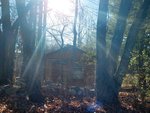Legislation has passed the Rhode Island State Senate aimed at helping developers build solar fields without clearing carbon-eating trees.
On Tuesday, the Senate unanimously passed what a press …
This item is available in full to subscribers.
We have recently launched a new and improved website. To continue reading, you will need to either log into your subscriber account, or purchase a new subscription.
If you are a current print subscriber, you can set up a free website account by clicking here.
Otherwise, click here to view your options for subscribing.
Please log in to continue |
|



Legislation has passed the Rhode Island State Senate aimed at helping developers build solar fields without clearing carbon-eating trees.
On Tuesday, the Senate unanimously passed what a press release called “an innovative plan to help set the stage for the future of solar development in Rhode Island.”
The bill is sponsored by Sen. Alana DiMario (D-District 36, North Kingstown, Narragansett and New Shoreham), and creates the Rhode Island Renewable Ready program.
The program, according to the Rhode Island General Assembly press release, will help “ensure renewable energy projects, such as solar farms, are built without increasing electric rates or clearing Rhode Island’s forests.”
“In 2021, we passed the Act on Climate,” said DiMario. “In 2022, we passed the renewable energy standard and our offshore wind development plan. This year, we need to create our plan for the next ten years of solar development in Rhode Island. This bill is a huge step forward in ensuring our energy is affordable, clean and reliable.”
Johnston Mayor Joseph Polisena Jr. said he feels local solar projects should be taken on a case-by-case basis.
“I’m supportive of encouraging and incentivizing rooftop solar,” Polisena explained via email Wednesday morning. “However, residents need to remember most of the woods they see is owned by private individuals, not the government, and is zoned residential. This means those property owners have the legal right to erect new housing developments, within the proper boundaries (R7, R10, R15, R20, or R40), without any zoning approval. Therefore, I believe each solar project should be determined on its own merits and the abutting property owners should voice their opinion as to whether they would rather have solar or new houses erected next to them. Just like many other issues, I would oppose any one-size-fits-all approach from the state.”
The new state program “would help offset the costs to prepare certain sites for renewable energy development,” according to the press release. “Eligible locations would include rooftops of large buildings, properties adjacent to major roads and so-called brownfield sites.”
Ocean State Job Lot opened a solar installation on the rooftop of their Johnston location last year.
Several solar projects are pending elsewhere in Johnston. Developers have been proposing solar fields in residential communities, sometimes clearing forested land to build large solar arrays. Residents have pushed back on solar projects pitched by local solar companies Green Development and Revity Energy, for residential neighborhoods.
“Why don’t you just put them on rooves?” That's a familiar question launched by neighborhood solar development opponents who argue in favor of solar, but not at the cost of woodland and space for housing.
“As you know I, along with many taxpayers in Johnston, have been opposing large-scale solar projects from being placed in residential neighborhoods,” said Johnston Town Councilman Robert J. Civetti. “From the start we have all stated that we were not against solar but we were opposed to placing them in neighborhoods that are zoned residential.”
The pending legislation aims to target brownfield sites for development. The press release defines a brownfield as a “former industrial area where potential or actual contamination complicates development.”
“Common examples of brownfields include former gas stations, metal plating facilities and dry cleaners,” according to the General Assembly press release. “Often, there is federal or settlement money available for the remediation of brownfield sites that the Renewable Ready program could tap into to fund clean-ups. That would ensure the costs to prepare these preferred sites for solar development would not be passed along to ratepayers.”
The Renewable Ready program, would task the Ocean State’s Office of Energy Resources and Department of Environmental Management (DEM), with identifying “sites such as brownfields or large rooftops that are preferred for solar development over forested sites or greenspaces,” according to the General Assembly. “The Rhode Island Infrastructure Bank would establish a fund with available federal or other allocated dollars to award to successful applicants to offset the costs of connecting solar developments sited on these targeted areas to the electric grid. The Rhode Island Infrastructure Bank operates a revolving fund and works with public and private capital providers.”
Drafters of the legislation drew inspiration from the “innovative Site Readiness model, originally used in the Quonset Business Park in North Kingstown to promote economic development,” according to the press release. That model has been employed “throughout Rhode Island via the RI Ready program,” at sites throughout the state, including downtown Johnston.
In February, Johnston Town Council voted unanimously to permit Polisena Jr. to enter into an agreement between Johnston, the Quonset Development Corporation (QDC), Winfield Realty Company, Inc. and the owners of AA Wrecking & Asbestos Abatement Co., Inc. to enter the business, at 1307 Hartford Ave., into the Rhode Island Ready Program.
The property, located behind the Johnston Senior Center, might welcome a new industry to town. Or, if DiMario’s bill is signed into law, might one day provide solar energy to Rhode Island’s power grid.
“I think that this legislation is terrific especially since in section 42-140.5-1 it states that the legislation will help ‘preserving the most valuable forests,’” Civetti said. “Also section 42-140.5-3 provides an identification of eligible sites which coincides much with what I along with the Johnston residents have been asking for. These solar farms can go on land adjacent to highways, landfills, roof tops, contaminated sites, while still maintaining our forests and residential neighborhoods.”
DiMario, who serves as chairwoman of the Senate Committee on Environment and Agriculture, collaborated with Senator Dawn Euer (D-Dist. 13, Newport, Jamestown) to design the legislation.
“This plan is really innovative and exciting,” Euer said. “We can use federal and other available funds to proactively identify and prepare these sites for solar development. That means more clean energy, more jobs and more affordable electricity rates.”
Rhode Island legislators passed the Act on Climate two years ago, “committing the state to carbon neutrality by 2050.”
“In 2022, the state passed among the boldest clean energy plans in the country, requiring 100 percent of the state’s electricity come from local renewable sources by 2033,” according to the General Assembly press release. “Also in 2022, the state established a plan and sent out a request for proposals for offshore wind. Now, advocates say, the state must better plan solar development.”
“By preparing sites where we want solar, we’ll ensure development where it makes sense,” said Priscilla De La Cruz, Senior Director of Government Affairs at Audubon Society of Rhode Island and President of the Environment Council of Rhode Island (ECRI). “Right now, it’s often cheaper for a company to clear-cut some forest than it is to remediate a contaminated site or put panels on the roof of a big building. But with the Renewable Ready program, we can flip that script, reducing carbon emissions, protecting our forests and saving ratepayers money all at the same time.”
This statement was music to Civetti’s ears.
“This is all that the solar group in Johnston has been asking for,” he said Wednesday morning. “Let’s put these solar farms where they belong and that is not in the middle of residential neighborhoods or on residentially zoned property.”
The legislation passed unanimously by the Senate (on a vote of 38 to 0) now heads to the Rhode Island state House of Representatives.
“The path forward for the next 10 years of solar development needs to focus on responsible land use, high labor standards and minimizing ratepayer impact so we can all benefit from energy generation that is both cleaner and less expensive than fossil fuels,” DiMario said. “Renewable Ready will mean protecting our forests, creating jobs and producing more clean energy, all while using federal or other available funds so ratepayers won't see their bills go up. It’s the next step in moving our energy system forward.”
Johnston state Rep. Deb Fellela said that she “realize(s) this is the way of our future and solar is an important part to make air cleaner/efficient.”
“However, we do need to be mindful of open spaces especially in towns where residents make their homes,” Fellela warned. “I don't think they belong in neighborhoods, even if they are just 20 years. I do see a solar farm off the highway near the airport and something like that makes sense. As homes wouldn't be built in that area anyway. I also hope the grid can handle all these changes. I think it is a commonsense issue. We can't expect folks to go all electric with homes, appliances and gardening/snow equipment too quickly. Along with vehicles also, this has to be done in a gradual manner, not to hurt the consumers. However, if renewable energy can help with the costs to residents, I'm for it.”
Fellela plans to vote for the legislation when it comes before the House.
Comments
No comments on this item Please log in to comment by clicking here